Notes: Goldsborough station was on the railway between York and Harrogate, standing at the point where there was a level crossing over the York-Knaresborough road (A59); since the early 1970s the road has been diverted to cross above the line by a bridge. The York to Harrogate railway is still open and thriving although it was on the Beeching closure list in 1963 – five years after Goldsborough closed to passengers.
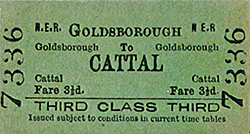 Although the nearest village to the station is Flaxby, half a mile to the north-east, the name of Goldsborough, a village a mile to the south, was chosen. This was probably influenced by the presence of Goldsborough Hall – the stately home of the Lascelles family since the mid eighteenth century – in the way that the neighbouring station of Allerton (later Hopperton) took its name from a nearby stately home; or the choice of ‘Goldsborough’ rather than Flaxby might have been made to avoid confusion with Flaxton, a station on the York to Scarborough line. When the station first appeared in Bradshaw in February 1851 the spelling was Gouldsborough, corrected in 1853, although the Railway Clearing House Handbook persisted with the early spelling until 1899. In the 1904 issue, although more than enough space was available for the full name, it had contracted to Goldsbro’. Although the nearest village to the station is Flaxby, half a mile to the north-east, the name of Goldsborough, a village a mile to the south, was chosen. This was probably influenced by the presence of Goldsborough Hall – the stately home of the Lascelles family since the mid eighteenth century – in the way that the neighbouring station of Allerton (later Hopperton) took its name from a nearby stately home; or the choice of ‘Goldsborough’ rather than Flaxby might have been made to avoid confusion with Flaxton, a station on the York to Scarborough line. When the station first appeared in Bradshaw in February 1851 the spelling was Gouldsborough, corrected in 1853, although the Railway Clearing House Handbook persisted with the early spelling until 1899. In the 1904 issue, although more than enough space was available for the full name, it had contracted to Goldsbro’.
The western end of the York - Harrogate route originated on 21 July 1845 when the Leeds & Thirsk Railway (L&T) was authorised to construct a branch from its planned main line at Starbeck (where it skirted the eastern fringe of Harrogate) to Knaresborough. The East & West Yorkshire Junction Railway (EWYJ) – described by Hoole (1974) as a protégé of George Hudson’s York & North Midland Railway (YNM) – was authorised on 16 July 1846 to build from York to Knaresborough. The L&T seemed to be showing excessive interest in the EWYJ in 1847, but Hudson’s influence won the day. At the opening the line from Skelton Junction, where the new route diverged from the Hudson’s York, Newcastle & Berwick Railway, the latter company provided the motive power. The western terminus at its opening on 30 October 1848 was at Hay Park Lane, about a mile east of Knaresborough, and this is where Goldsborough station’s westbound train departures initially terminated. This temporary measure was necessary because the L&T’s viaduct over the River Nidd in Knaresborough collapsed on 11 March 1848 as it neared completion. The successfully completed viaduct over the Nidd was a fine structure notable for its castellated piers complementing the ruins of the nearby castle.
On 21 July 1851 the Leeds Northern Railway (renamed from L&T on 3 July) branch from Starbeck opened to meet the line from York at Knaresborough. What is now Starbeck station was identified in Bradshaw by various names – including Harrogate, Harrogate & Knaresborough, High Harrogate and Harrogate High – until it settled down to be Starbeck in 1857. Trains on the Leeds and Wetherby lines used another Harrogate station (the terminus usually suffixed ‘Brunswick’ in modern literature to distinguish it from the present station which replaced it in 1862).
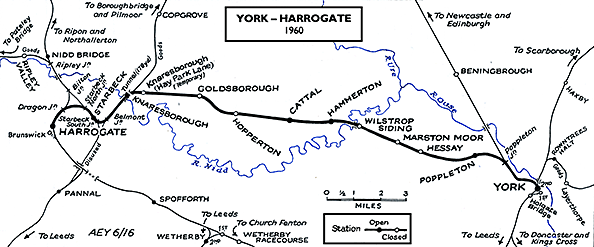
From 1851 the EWYJ operated its own motive power with the assistance of E B Wilson & Co, locomotive builders of Leeds. On 28 May 1852 the EWYJ was absorbed into the YNM company; the L&T had been renamed the Leeds Northern Railway (LN) on 3 July 1851; and both the YNM and LN companies became part of the newly-formed North Eastern Railway in 1854. The present Harrogate station opened on 1 August 1862; it became the western terminus of the line from York and replaced the Brunswick terminus, as mentioned above.
From the outset, the EWYJ provided intermediate stations between York and Knaresborough at Poppleton, Marston (later Marston Moor), Cattal and Allerton (later Hopperton). Their buildings were surprisingly large given the limited populations that the stations would serve. Within two years further stations were provided at Hessay, Hammerton and Goldsborough level crossings, but it is possible that trains called at these places from the opening of the line; early passenger timetables for North East England are known to have omitted certain stations that were in use. In all three places there were level crossings where the gatekeepers’ houses could be incorporated into a passenger station.
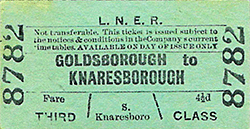 At Goldsborough the gatehouse was on the up (north) side of the tracks, west of the crossing. Fawcett (2001) notes that it was a modest single-storey house of two rooms (a living kitchen and a bedroom) with a bay window facing the tracks. The building was dignified by chamfered stone quoins and a decorative wooden pendant on the gable. To provide for its new role as a passenger station a waiting room block was added to the west side of the gatehouse, and the house was raised to two storeys. The quoins were not continued onto the second storey and a stone cill-band was carried across instead. Outsized scalloped bargeboards were added which lent a cottage ornée quality to the building, setting it apart from other stations on the line. Why Goldsborough merited this distinction is unclear, although it might have been to appeal to the Lascelles family and their discerning guests. The up platform was built in front of the gatehouse, west of the crossing, but the down platform was ‘staggered’ east of the crossing. Both platforms were given timber waiting sheds by the NER of a standard pent-roof design. At Goldsborough the gatehouse was on the up (north) side of the tracks, west of the crossing. Fawcett (2001) notes that it was a modest single-storey house of two rooms (a living kitchen and a bedroom) with a bay window facing the tracks. The building was dignified by chamfered stone quoins and a decorative wooden pendant on the gable. To provide for its new role as a passenger station a waiting room block was added to the west side of the gatehouse, and the house was raised to two storeys. The quoins were not continued onto the second storey and a stone cill-band was carried across instead. Outsized scalloped bargeboards were added which lent a cottage ornée quality to the building, setting it apart from other stations on the line. Why Goldsborough merited this distinction is unclear, although it might have been to appeal to the Lascelles family and their discerning guests. The up platform was built in front of the gatehouse, west of the crossing, but the down platform was ‘staggered’ east of the crossing. Both platforms were given timber waiting sheds by the NER of a standard pent-roof design.
The platform arrangement here was the reverse of the ‘stagger’ at Hopperton. With the up platform at Goldsborough being west of the level crossing the engine would be likely to obstruct it when trains stopped here, requiring the gates to be closed for a considerable time, so causing queues of traffic on the main road.
Although in the earliest days of the York–Knaresborough service there were Sunday trains, the table below for February 1863 indicates only a weekday service, which was to be the normal state of affairs for the route. The Harrogate terminus is the present-day station which, as noted earlier, had opened in 1862.
Up trains: weekdays February 1863 |
Destination |
Down trains: weekdays |
Destination |
9.52am |
York |
8.04am |
Harrogate* |
12.23pm |
York |
10.58am |
Harrogate* |
4.43pm |
York |
2.30pm |
Harrogate* |
7.08pm |
York |
5.18pm |
Harrogate* |
- |
- |
8.17pm ‡ |
Harrogate* |
Notes: ‡ Approximate time; calls by request *Timetable heading refers to the station as ‘High Harrogate’ – presumably owing to inertia, as High Harrogate had been named Starbeck since 1857.
Between York and Knaresborough the railway passed through lightly populated countryside with a scattering of villages and isolated farms, and the frequency of train calls at Goldsborough was similar to the other rural stations on the line in the late nineteenth century - with the exception of Wilstrop Siding which had only a Saturday service of one train stopping in each direction. The 1896 table shows the situation shortly before road motor transport began to offer competition to the trains. The Wednesday-only arrival at 3.26pm is for passengers to alight having visited Knaresborough market.
Up trains: weekdays July 1896 |
Destination |
Down trains: weekdays |
Destination |
7.46am |
York |
7.56am |
Harrogate |
11.31am |
York |
10.49am |
Harrogate |
1.11pm |
York |
1.19pm |
Harrogate |
3.26pm (Wed only)* |
York |
3.59pm |
Harrogate |
4.56pm |
York |
5.39pm |
Harrogate |
8.01pm |
York |
8.29pm |
Harrogate |
Note: *Market Train
NER records show that Mr H Hick was an early stationmaster at Goldsborough who moved to the same post at Marston Moor (then known as Marston) in April 1879.
The NER estimated the population served by Goldsborough station in 1911 to be 374, and in that year 4,405 tickets were issued – a very modest number for that time. NER records for 1913 show that livestock and 251 tons of barley were handled at the station. The goods facilities and coal depot with weigh office were located west of the up platform, together with a small timber-built warehouse beside the crossing.
For much of its length the main road between York and Knaresborough (now the A59) was within a mile of the railway, and after World War 1 road motor services began to offer competition to trains. The local villages, however, with the exception of Green Hammerton, were some distance from this road, and buses would need to make numerous diversions from it to serve them adequately; thus (with the exception of Wilstrop Siding) the wayside stations would survive into the 1950s or, in the cases of Poppleton, Hammerton and Cattal, remain open today. This is in contrast to the lines between Malton and Scarborough, and Malton and Gilling, where all the villages were strung along a parallel main road, and their stations closed in 1930-31.
Up trains: weekdays June 1920 |
Destination |
Down trains: weekdays |
Destination |
7.41am |
York |
7.57am |
Harrogate |
8.53am |
York |
10.59am |
Harrogate |
11.15am |
York |
1.19pm |
Harrogate |
1.05pm |
York |
3.56pm |
Harrogate |
3.35pm |
York |
5.46pm |
Harrogate |
5.18pm |
York |
8.29pm |
Harrogate |
8.20pm |
York |
- |
- |
In January 1923 the NER was absorbed into the new London & North Eastern Railway at the ‘Grouping’. Under this regime the level of passenger train service was maintained at approximately its earlier frequency. The station retained its Victorian atmosphere in its rural isolation and continued to be lit by NER oil lanterns. NER records show that Mr H V Donaldson was stationmaster at Goldsborough until his retirement in August 1922, shortly before the NER era closed.
The station enjoyed royal connections in the LNER era. Goldsborough Hall was the first home of Princess Mary, later the Princess Royal (only daughter of King George V and Queen Mary) after her marriage to Viscount Lascelles, 6th Earl of Harewood, in 1922. The following year Goldsborough station welcomed King George V and the young Duke of Kent who arrived for the christening of the King’s grandson, George Lascelles, 7th Earl of Harewood, at the local church. The royal train used Goldsborough station once again in 1925. However, royalty usually came to Harrogate on a train from Kings Cross, with a royal saloon attached, which ran not via York or Leeds but via Church Fenton and Spofforth. Rather than change the royal saloon from one train to another at Harrogate, and then motor from Goldsborough station to Goldsborough Hall, it was quicker, and more convenient, for the royal party to drive the short distance directly from Harrogate station to Goldsborough Hall. These visits were private and the royal party simply stepped from the railway carriage into a waiting car and drove off, and vice versa on the return journey.
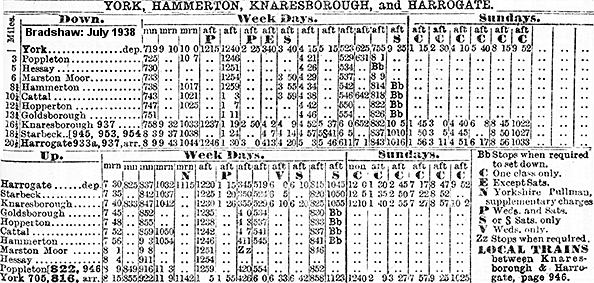
The LNER, looking for ways to economise, ceased to provide a stationmaster at Allerton (the neighbouring station, soon to be renamed Hopperton) and brought this station under the supervision of Goldsborough. In August 1924 G Milner, previously stationmaster of Kettleness near Whitby, was appointed to this joint role. In September 1935 S Hill was promoted from goods clerk at York to take on the stationmaster’s role at Goldsborough and Hopperton. He moved on to be stationmaster of Coxwold in June 1937, and his successor at Goldsborough, W Morrill (or Merrill?) moved from his porter / signalman post to be stationmaster of Goldsborough alone; Hopperton had its own stationmaster from this time. It is not known how long Mr Morrill was in post – he possibly stayed at Goldsborough until his death in March 1963.
The 1938 timetable below includes late evening calls by request on Saturdays, presumably enabling local people to return from visits to the cinema in York, Knaresborough or Harrogate. For most of its life the York–Harrogate line had no Sunday service; however Sunday trains were provided in summer 1938, but they did not call at Goldsborough.
Up trains: weekdays July 1938 |
Destination |
Down trains: weekdays |
Destination |
7.45am |
York |
7.51am |
Harrogate |
8.52am |
York |
1.11pm |
Harrogate |
12.35pm |
York |
4.46pm |
Harrogate |
4.00pm |
York |
5.54pm |
Harrogate |
5.34pm |
York |
8.26pm |
Harrogate |
8.30pm |
York |
10.00pm (Saturday only)§ |
Harrogate |
11.00pm (Saturday only)§ |
York |
- |
- |
Note: § Approximate time; calls by request to set down passengers
The scene at Goldsborough station was to change with the outbreak of World War 2 when a huge brick building was constructed immediately north-west of the station: a refrigerated cold store where the Ministry of Food could house emergency meat supplies. On completion, the cold store was given a rail connection with two private sidings running either side of the brick monolith, and two reception loop sidings. In 1941, identical brick refrigerated cold stores were built in 43 locations by William Douglas & Sons. They were scattered around the country as part of an integrated system of food control, distribution and handling, and all were located adjacent to main railway routes for ease of movement in and out of the stores. The sites selected were away from primary target areas with the exception of Wolverhampton and Aintree.
 It was essential that rail access to the Ministry of Food store was secure, and, to this end, Goldsborough’s diminutive timber signal box was replaced with an ARP (Air Raid Precaution) box of robust brick construction, between the station building and the level crossing; it opened on 10 November 1942. Such boxes were not designed so much to withstand a direct hit in an aerial bombing raid as to survive blast damage. Around 45 ARP design signal boxes were built during World War 2, and the London & North Eastern Railway built about 20. Because many locations that were provided with ARP signal boxes were created specifically for the war effort, quite a number of these boxes had only a very short operational life; however, at Goldsborough the level crossing gates had to be operated and the goods facilities controlled which ensured the survival of the ARP box. It was essential that rail access to the Ministry of Food store was secure, and, to this end, Goldsborough’s diminutive timber signal box was replaced with an ARP (Air Raid Precaution) box of robust brick construction, between the station building and the level crossing; it opened on 10 November 1942. Such boxes were not designed so much to withstand a direct hit in an aerial bombing raid as to survive blast damage. Around 45 ARP design signal boxes were built during World War 2, and the London & North Eastern Railway built about 20. Because many locations that were provided with ARP signal boxes were created specifically for the war effort, quite a number of these boxes had only a very short operational life; however, at Goldsborough the level crossing gates had to be operated and the goods facilities controlled which ensured the survival of the ARP box.
Whilst many lines and stations experienced a markedly reduced train service during World War 2, the relatively infrequent service between York and Harrogate was little changed, and the June 1943 timetable shows five up calls (six on Saturday) at Goldsborough and five in the opposite direction. In January 1948 the route became part of British Railways’ North Eastern Region. The region’s first published timetable shows the following service, with a declining number of calls at Goldsborough station:
Up trains: weekdays May 1948 |
Destination |
Down trains: weekdays |
Destination |
7.40am |
York |
7.50am |
Harrogate |
12.51pm |
York |
1.01pm (Sat excepted) |
Harrogate |
4.02pm |
York |
1.36pm (Sat only) |
Harrogate |
5.35pm |
York |
4.55pm |
Harrogate |
8.32pm |
York |
- |
- |
Owing to the decline in use of rural stations, in the early 1950s the neighbouring branch line from Harrogate to Pateley Bridge closed to passengers as did the branch from Knaresborough to Pilmoor on the East Coast main line. On the York–Harrogate route all stations that survived to nationalisation remained open, but in 1952/53 economies were effected by reducing the number of train calls at the quietest stations, making the services less attractive. In summer 1955 the service at Goldsborough was reduced to one train in each direction in the morning; all activity was packed into just six minutes. Workers leaving by these trains would have to make other arrangements for their homeward journey. It is likely that these calls were principally to drop off parcels.
Up trains: weekdays June 1958 |
Destination |
Down trains: weekdays |
Destination |
7.41am |
York |
7.47am |
Harrogate |
This was to be the station’s final timetable. On 15 September 1958 the North Eastern Region closed a large number of stations to passengers, principally on the East Coast main line in Yorkshire and Northumberland, but Goldsborough and three other York–Harrogate stations (Hessay, Marston Moor and Hopperton) were included in the purge. For no obvious reason, Goldsborough and its neighbours were left intact for over a decade, with platforms, buildings and even nameboards in place, whilst the normal policy in the region was to remove nameboards promptly and demolish the trackside edge of the platforms to prevent them from crumbling and falling onto the rails. The author remembers the remarkably good condition of these stations when travelling between York and Harrogate in 1961 and 1966, and John Mann’s photographs of Goldsborough, 11 years after closure in 1969, are evidence of this unusual situation. The goods yard at Goldsborough station closed in May 1965. At Marston Moor a westbound daily parcels train continued to call until at least 1967 which possibly explains why that station’s down platform was left in place.
The wartime storage facility adjacent to Goldsborough station continued to perform its function during the early years of the ‘cold war’. The storage of food in the UK peaked in 1956 with some 750,000 tons held in various depots including the 43 massive government-owned cold stores. That year, however, their role was downgraded and their operation was handed over to contractors to operate, in the same way as buffer food depots. Although they were now commercial operations, the Ministry of Food rented space in some of the stores. By 1961 there was seen to be no need to have emergency meat stocks and the sites were rented out as commercial cold stores with no strategic value. In 1985 some of the buildings were considered for use as Regional Government Control Centres. Most however, including Goldsborough, continued in use as a commercial cold store. It was occupied by Manton Transport Ltd but in 2012 Chippindale Foods bought the building; they soon demolished it and built a new distribution depot on the site.
The York-Harrogate route was recommended for closure by Beeching in 1963. As noted earlier, for much of its length the railway runs parallel and close to the A59 road, and the only significant population centre served is Knaresborough, with fewer than 10,000 inhabitants in 1961. On 23 September 1964 official notice was given of the intention to close the line, but on 15 September 1966 Barbara Castle, Minister of Transport, refused on the grounds of hardship that would be caused.
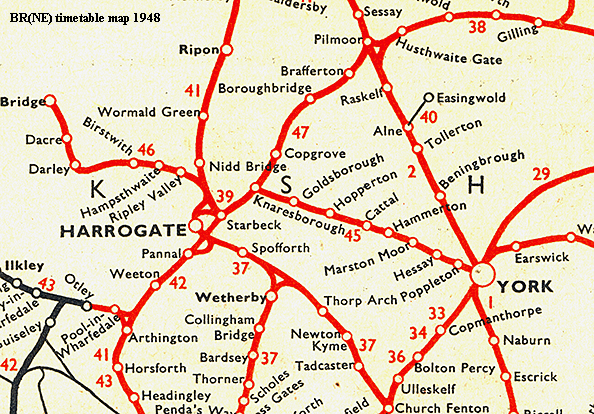
The A59 level crossing at Goldsborough had been replaced with a bridge on 29 January 1971, and on 17 February 1971 the signal box was closed. Economies were exercised by introducing single-line working on 4 June 1972 between Poppleton and Hammerton; the section between Cattal and Knaresborough, through Goldsborough, was similarly downgraded on 16 December 1973, and the removal of the redundant track was completed by 3 March 1974. Some time after 1978 the station house was extended eastwards and the signal box was incorporated into it; the lower floor of the box was converted into a garage.
One of the curiosities of the York – Harrogate line is that in 2016 it remains a stronghold of semaphore signals and manually operated, attended level crossing gates. There are probably several factors at work to explain this. At present there is no problem with availability of staff for these duties. The equipment installed when track-singling was carried out in the 1970s is still serviceable, and with restoration of double track and even electrification in prospect it would make little sense to automate the crossings and train control until it is clear how and when the route will be upgraded – which surely will happen soon. Once considered expendable, the York-Harrogate route has gone from strength to strength with an hourly weekday service operating to and from Leeds and stopping at all stations; a further hourly service runs between Knaresborough, Harrogate and Leeds, and there are also frequent Sunday trains. On a number of recent journeys between Harrogate and York the author has noted that the trains are well-used, sometimes with standing room only, even outside the rush hour. Organised holidays tours based in Harrogate but visiting York for the day provide many passengers for the line during the summer half of the year.
In 2019 plans are progressing for the development of 2,750 homes on the former golf course at Flaxby Park close to Goldsborough station. The development company, Flaxby Park Ltd, has acquired the former Goldsborough station building and has approached Network Rail about the feasibility of a new station to serve the proposed housing area. Network Rail has confirmed that there are no significant technical obstructions to providing a new station to serve the development. This potential source of customers on a railway route which is already experiencing an increase in passengers can only strengthen the case for electrification.
Tickets from Michael Stewart. Route map drawn by Alan Young
BIBLIOGRAPHY:
- Bairstow, Martin Railways around Harrogate: Vol 1 (Author, 1989)
- Biddle, Gordon Victorian stations (David & Charles, 1973)
- Biddle, Gordon Britain’s historic railway buildings (Oxford University Press, 2003)
- Clinker, C R Clinker’s register of closed passenger stations and goods depots (Avon-Anglia, 1978)
- Fawcett, Bill A history of North Eastern Railway architecture: Vol 1 The Pioneers (North Eastern Railway Association, 2001)
- Goode, C T The York, Knaresborough and Harrogate Railway (Author, 2001)
- Hoole, Ken A regional history of the railways of Great Britain: Vol 4 The North East (David & Charles, 1974)
- Hoole, Ken Railway stations of the North East (David & Charles, 1985)
- Quick, Michael Railway passenger stations in Great Britain: a chronology (Railway & Canal Historical Society, 2009)
- Young, Alan Lost stations of Yorkshire Part 1: The West Riding (Silver Link Publishing Ltd, 2015).
- Signalling website
GOLDSBOROUGH ONLY:
To see other closed station on the York - Harrogate line click on the station name: Hessay, Marston Moor, Wilstrop Siding, Hopperton & Knaresborough (Hay Park Lane) |

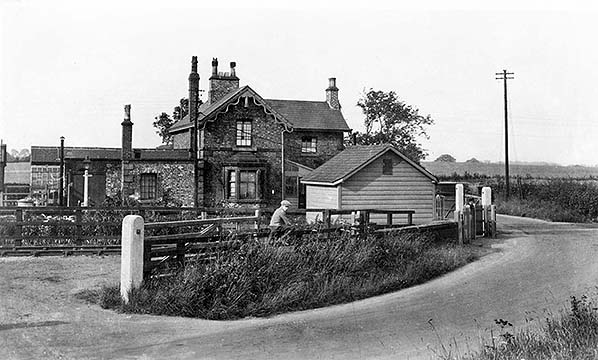
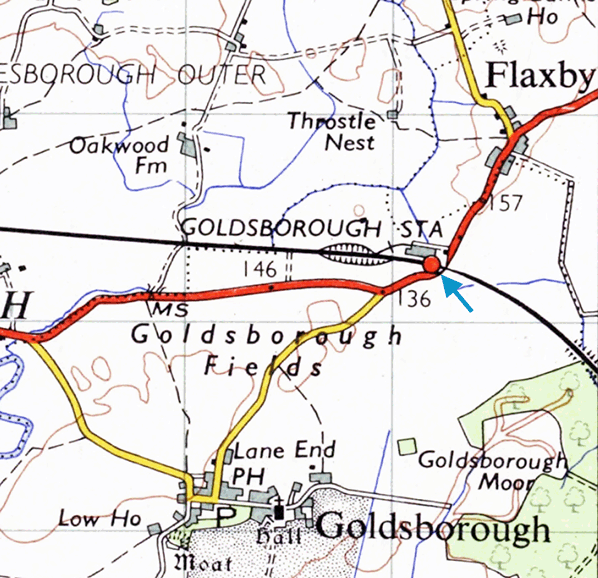
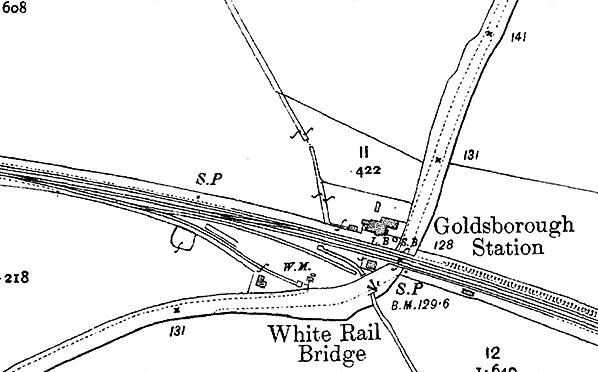
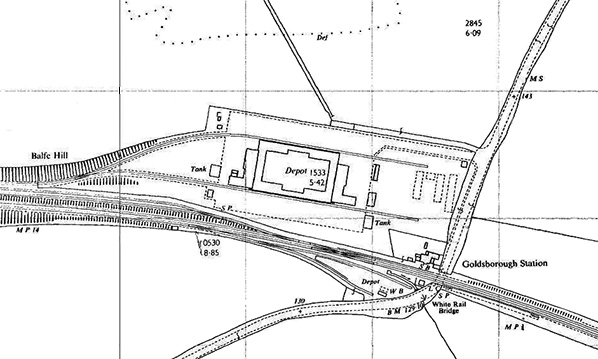
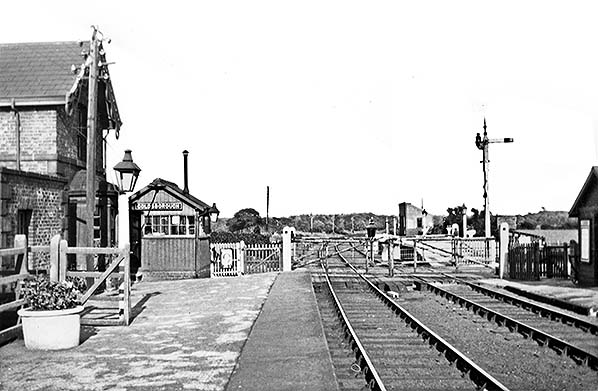
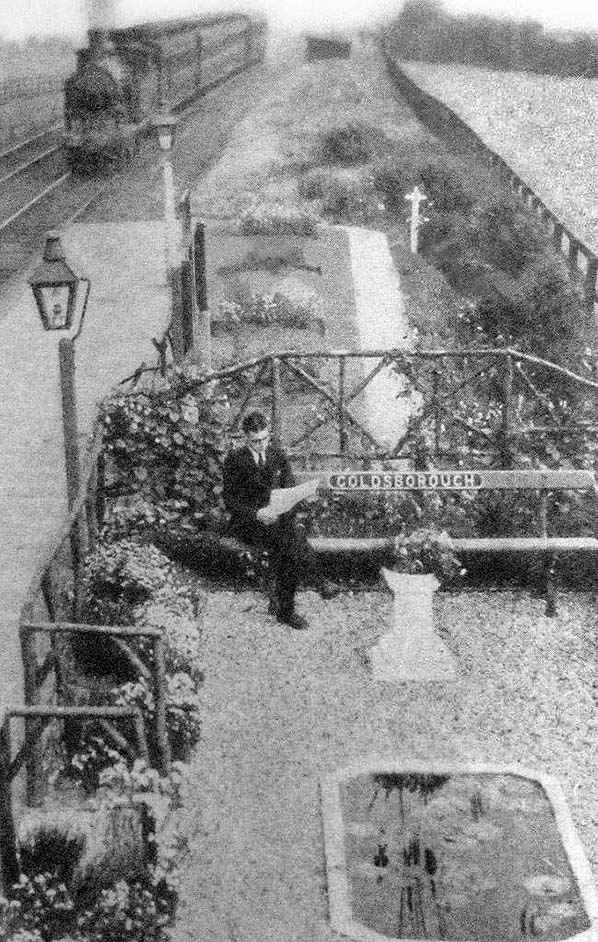
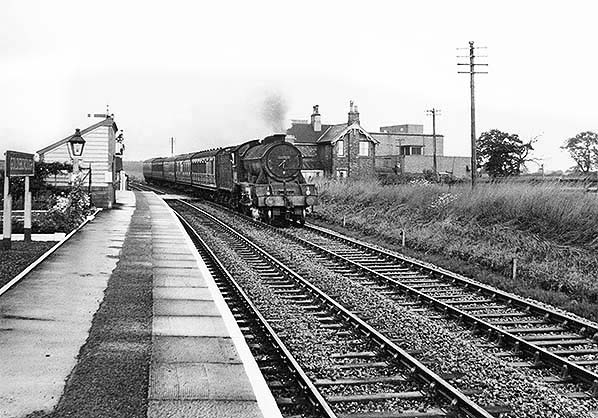
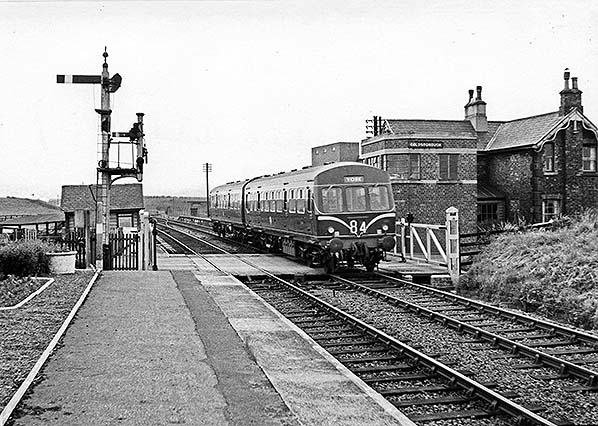
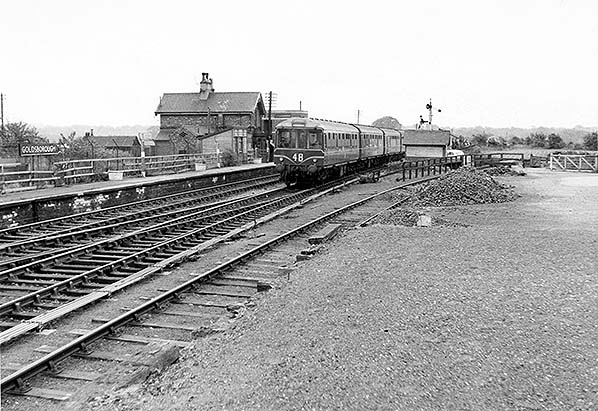
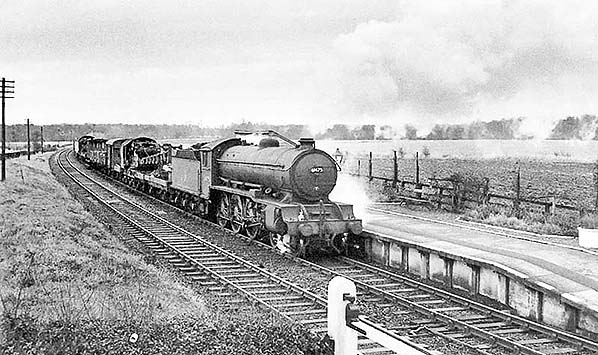

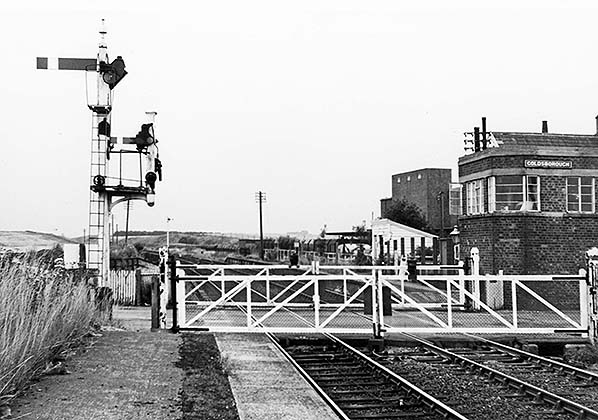
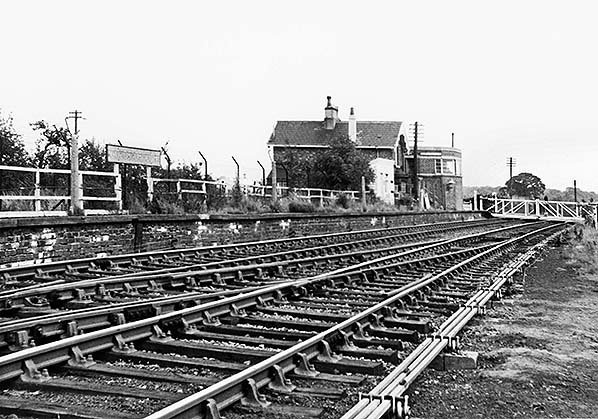
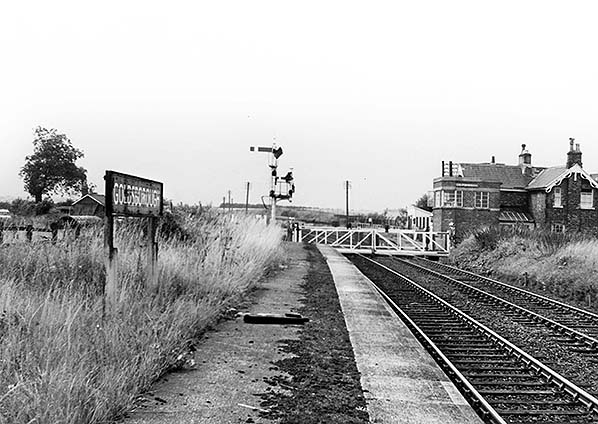
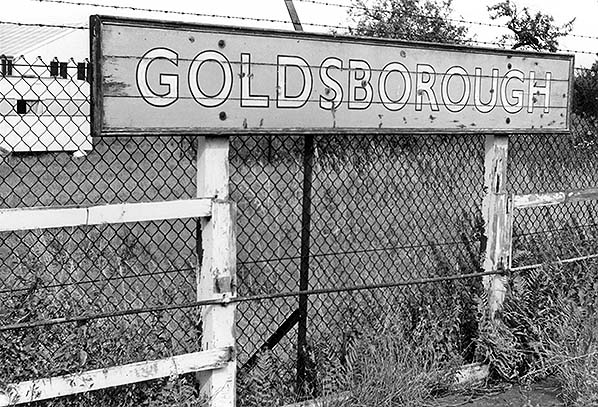
 Although the nearest village to the station is Flaxby, half a mile to the north-east, the name of Goldsborough, a village a mile to the south, was chosen. This was probably influenced by the presence of Goldsborough Hall – the stately home of the Lascelles family since the mid eighteenth century – in the way that the neighbouring station of Allerton (later Hopperton) took its name from a nearby stately home; or the choice of ‘Goldsborough’ rather than Flaxby might have been made to avoid confusion with Flaxton, a station on the York to Scarborough line. When the station first appeared in Bradshaw in February 1851 the spelling was Gouldsborough, corrected in 1853, although the Railway Clearing House Handbook persisted with the early spelling until 1899. In the 1904 issue, although more than enough space was available for the full name, it had contracted to Goldsbro’.
Although the nearest village to the station is Flaxby, half a mile to the north-east, the name of Goldsborough, a village a mile to the south, was chosen. This was probably influenced by the presence of Goldsborough Hall – the stately home of the Lascelles family since the mid eighteenth century – in the way that the neighbouring station of Allerton (later Hopperton) took its name from a nearby stately home; or the choice of ‘Goldsborough’ rather than Flaxby might have been made to avoid confusion with Flaxton, a station on the York to Scarborough line. When the station first appeared in Bradshaw in February 1851 the spelling was Gouldsborough, corrected in 1853, although the Railway Clearing House Handbook persisted with the early spelling until 1899. In the 1904 issue, although more than enough space was available for the full name, it had contracted to Goldsbro’.
 At Goldsborough the gatehouse was on the up (north) side of the tracks, west of the crossing. Fawcett (2001) notes that it was a modest single-storey house of two rooms (a living kitchen and a bedroom) with a bay window facing the tracks. The building was dignified by chamfered stone quoins and a decorative wooden pendant on the gable. To provide for its new role as a passenger station a waiting room block was added to the west side of the gatehouse, and the house was raised to two storeys. The quoins were not continued onto the second storey and a stone cill-band was carried across instead. Outsized scalloped bargeboards were added which lent a cottage ornée quality to the building, setting it apart from other stations on the line. Why Goldsborough merited this distinction is unclear, although it might have been to appeal to the Lascelles family and their discerning guests. The up platform was built in front of the gatehouse, west of the crossing, but the down platform was ‘staggered’ east of the crossing. Both platforms were given timber waiting sheds by the NER of a standard pent-roof design.
At Goldsborough the gatehouse was on the up (north) side of the tracks, west of the crossing. Fawcett (2001) notes that it was a modest single-storey house of two rooms (a living kitchen and a bedroom) with a bay window facing the tracks. The building was dignified by chamfered stone quoins and a decorative wooden pendant on the gable. To provide for its new role as a passenger station a waiting room block was added to the west side of the gatehouse, and the house was raised to two storeys. The quoins were not continued onto the second storey and a stone cill-band was carried across instead. Outsized scalloped bargeboards were added which lent a cottage ornée quality to the building, setting it apart from other stations on the line. Why Goldsborough merited this distinction is unclear, although it might have been to appeal to the Lascelles family and their discerning guests. The up platform was built in front of the gatehouse, west of the crossing, but the down platform was ‘staggered’ east of the crossing. Both platforms were given timber waiting sheds by the NER of a standard pent-roof design. 
 It was essential that rail access to the Ministry of Food store was secure, and, to this end, Goldsborough’s diminutive timber signal box was replaced with an ARP (Air Raid Precaution) box of robust brick construction, between the station building and the level crossing; it opened on 10 November 1942. Such boxes were not designed so much to withstand a direct hit in an aerial bombing raid as to survive blast damage. Around 45 ARP design signal boxes were built during World War 2, and the London & North Eastern Railway built about 20. Because many locations that were provided with
It was essential that rail access to the Ministry of Food store was secure, and, to this end, Goldsborough’s diminutive timber signal box was replaced with an ARP (Air Raid Precaution) box of robust brick construction, between the station building and the level crossing; it opened on 10 November 1942. Such boxes were not designed so much to withstand a direct hit in an aerial bombing raid as to survive blast damage. Around 45 ARP design signal boxes were built during World War 2, and the London & North Eastern Railway built about 20. Because many locations that were provided with 
 Home Page
Home Page